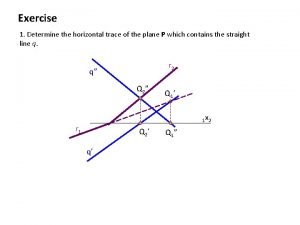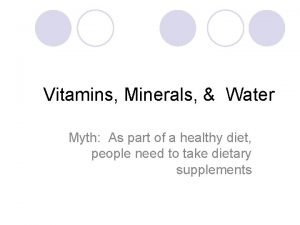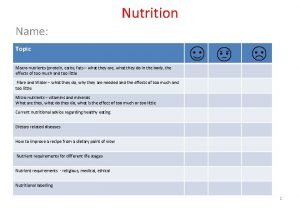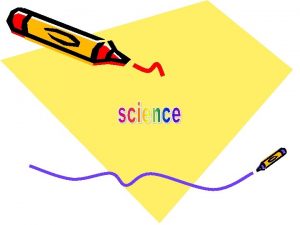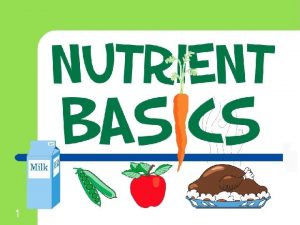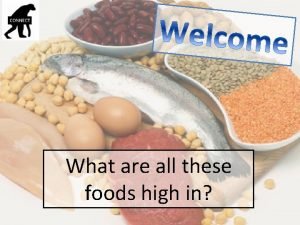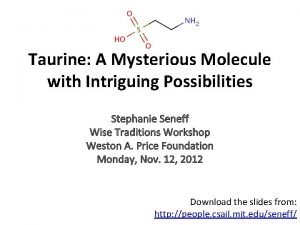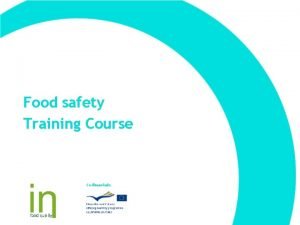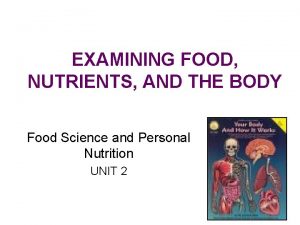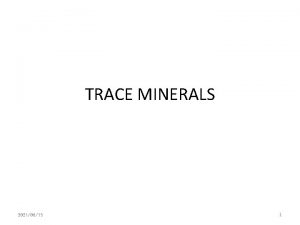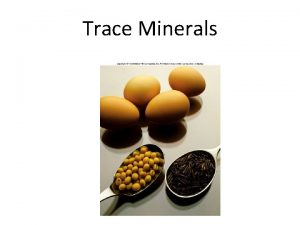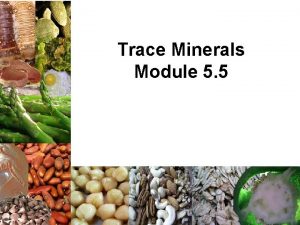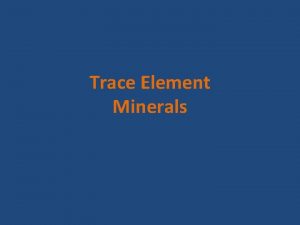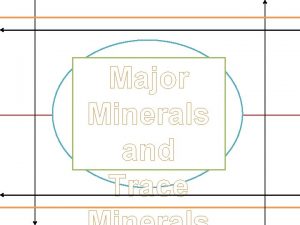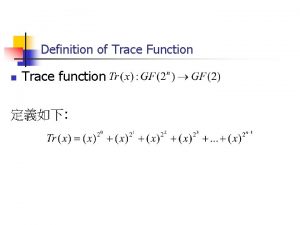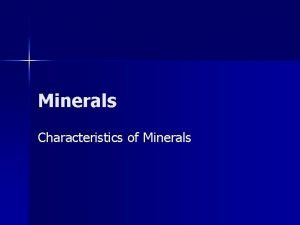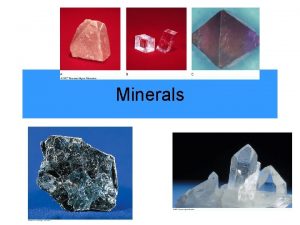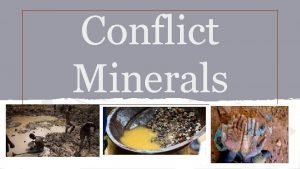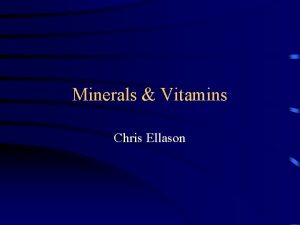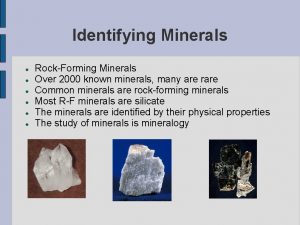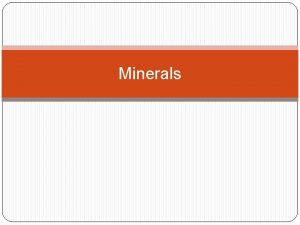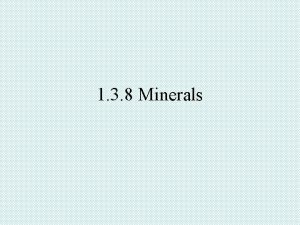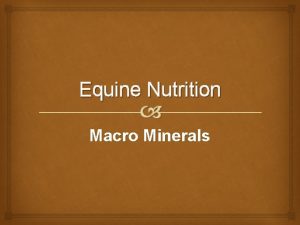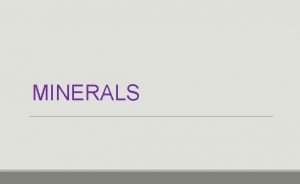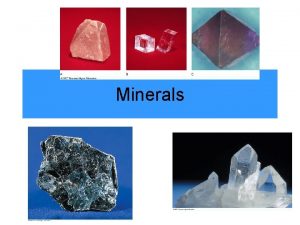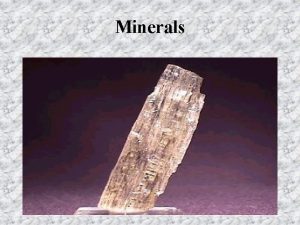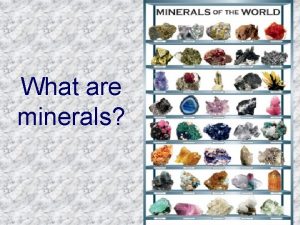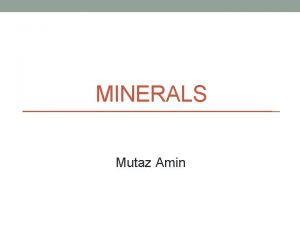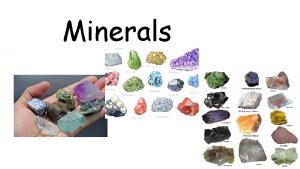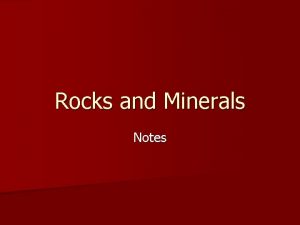The Trace Minerals ThomsonWadsworth Overview Food Sources Depends

































- Slides: 33

The Trace Minerals © Thomson-Wadsworth

Overview • Food Sources • Depends on soil and water composition • Depends on processing • Bioavailability • Wide variety of foods • Deficiencies • Mild deficiencies are easily overlooked. • Severe deficiencies are easy to recognize. • Deficiencies have wide-reaching effects. • Affects all ages • Toxicities • Do not exceed Upper Level Recommended Intakes. • Do not exceed 100% Daily Values. • FDA does not limit amounts in supplements. • Interactions • Common and coordinated to meet body needs • Can lead to nutrient imbalances

Iron • Forms – Ferrous (Fe++) – Ferric (Fe+++) • Roles in the Body • Ferrous iron is reduced and has a net positive charge of two. • Ferric iron is oxidized and has a net positive charge of three. • Cofactor in oxidation-reduction reactions • Part of the protein hemoglobin which carries oxygen in the blood • Part of the protein myoglobin in the muscles which makes oxygen available for muscle contractions • Utilization of energy in cell metabolism © Thomson-Wadsworth

• • • Iron Factors enhance nonheme iron absorption – MFP factor – Vitamin C – Citric acid – Lactic acid from foods – HCl from stomach – Sugars Factors inhibit nonheme iron absorption – Phytates – Fibers – Oxalates – Calcium – Phosphorus – EDTA – Tannic acid Individual Variation – Dietary factors – Health status – Stage in life cycle – Iron status © Thomson-Wadsworth

Iron Absorption Iron absorption © Thomson-Wadsworth

Iron Absorption Iron: Heme vs. Nonheme © Thomson-Wadsworth

Iron Absorption Iron Recycling © Thomson-Wadsworth

Iron • • • Significant sources – Red meats, fish, poultry, shellfish, eggs – Legumes, dried fruits 2001 RDA – Men: 8 mg/day – Women (19 -50 years): 18 mg/day – Women (51+ years): 8 mg/day Upper level for adults: 45 mg/day High risk for iron deficiency – Women in their reproductive years – pregnant women – Infants and young children – Teenagers Blood Losses – Giving a pint of blood loses about 2. 5 mg iron – Menstruation – Bleeding ulcers – Malaria and parasites © Thomson-Wadsworth

Iron © Thomson-Wadsworth

Iron • Stages of iron deficiency – Iron stores diminish – Transport iron decreases – Hemoglobin production declines. Blood cells in iron-deficiency anemia are small and pale because they contain less hemoglobin • Assessment of Iron Deficiency – Stage 1 - Iron stores diminish; measure serum ferritin – Stage 2 – Transport iron decreases; measure transferrin saturation – Stage 3 – Hemoglobin production declines; erythrocyte protoporphyrin accumulates and hematocrit declines © Thomson-Wadsworth

• Iron Deficiency and Anemia – Iron deficiency is depleted iron stores. – Iron-deficiency anemia is the severe depletion of iron stores. Also called microcytic hypochromic anemia. – Symptoms include fatigue, weakness, headaches, apathy, pallor and poor resistance to cold temperatures. • Iron Deficiency and Behavior – Energy metabolism is impaired. – Neurotransmitter synthesis is reduced. – Physical work capacity is reduced. – Mental productivity is reduced. © Thomson-Wadsworth

Iron • • Iron Deficiency and Pica – Habit of eating ice, clay, paste, and other nonfood substances – Generally in women and children from low-income groups Iron Toxicity – Iron Overload • Hemochromatosis is generally a genetic disorder that enhances iron absorption. • Repeated blood transfusions • Massive doses of supplemental iron • May cause hemosiderosis • Symptoms include apathy, lethargy, and fatigue • Problems include liver tissue damage and infections • Higher risk of diabetes, liver cancer, heart disease, and arthritis © Thomson-Wadsworth

– Iron and Heart Disease – may be a link to high iron stores – Iron and Cancer – may be a link with free radical activity – Iron Poisoning • Upper level for adults: 45 mg/day • Accidental supplement poisoning in children • Symptoms include nausea, vomiting, diarrhea, constipation, rapid heartbeat, weak pulse, dizziness, shock, and confusion © Thomson-Wadsworth


• Zinc Roles in the Body • Supports the work of metalloenzymes – Helps to make parts of DNA and RNA – Manufactures heme for hemoglobin – Assists in essential fatty acid metabolism – Releases Vitamin A from liver stores – Metabolizes carbohydrates – Synthesizes proteins – Metabolizes alcohol – Disposes damaging free radicals • Affects platelets in blood clotting and wound healing • Affects thyroid hormone function • Influences behavior and learning performance • Taste perception • Sperm development • Fetal development © Thomson-Wadsworth

Zinc • • • Zinc Absorption • Rate of absorption depends on zinc status • Phytates and fiber bind zinc and reduce absorption. • Metallothionein is a special protein that holds zinc in storage. Zinc Recycling • Enteropancreatic circulation • Losses occur in the feces. Zinc Transport • Transported by the protein albumin • Binds to transferrin © Thomson-Wadsworth

Zinc © Thomson-Wadsworth

Zinc • • • Significant sources – Protein-containing foods – Red meats, shellfish – Whole grains 2001 RDA – Men: 11 mg/day – Women: 8 mg/day Upper level for adults: 40 mg/day Deficiency symptoms – Growth retardation, delayed sexual maturation, impaired immune function, hair loss, eye and skin lesions, loss of appetite Toxicity symptoms – Loss of appetite, impaired immunity, copper and iron deficiencies Zinc Supplementation – Developing countries use zinc to reduce incidence of disease and diarrhea. – Zinc lozenges for the common cold are controversial and inconclusive. © Thomson-Wadsworth

Zinc © Thomson-Wadsworth

Iodine – Iodide Roles in the Body • Component of two thyroid hormones • Regulates growth, development, and metabolic rate – Iodine Deficiency • Simple goiter is the enlargement of the thyroid gland caused by iodine deficiency. Goiter is enlargement of the thyroid gland due to malfunction of the gland, iodine deficiency or overconsumption of goitrogens. • Cretinism is a congenital disease characterized by mental and physical retardation and commonly caused by maternal iodine deficiency during pregnancy. • Goitrogen overconsumption– naturally occurring in cabbage, kale, brussels sprouts, cauliflower, broccoli, and kohlrabi © Thomson-Wadsworth

Iodine – Iodine Toxicity • Upper level 1000 g/day • Symptoms include underactive thyroid gland, elevated TSH, and goiter • Supplement use, medications, and excessive iodine from foods – Iodine Recommendations and Sources • Recommendations (2001 RDA) Adults: 150 g/day • Sources – Iodized salt – Seafood – Bread and dairy products – Plants grown in iodine-rich soils – Animals that feed on plants grown in iodine -rich soils © Thomson-Wadsworth

Other Trace Minerals • Copper – Roles in the Body • Absorption and use of iron in the formation of hemoglobin • Part of several enzymes • Some copper containing enzymes are antioxidants. – Deficiency and Toxicity • Deficiency symptoms include anemia and bone abnormalities. • Menkes disease • Toxicity – Upper Level for Adults: 10, 000 g/day (10 mg/day) – Wilson’s disease © Thomson-Wadsworth

– Recommendations and Sources • Recommendations (2001 RDA) Adults: 900 g/day • Sources – Seafood, nuts, seeds and legumes – Whole grains © Thomson-Wadsworth

The Trace Minerals (cont’d. ) • Selenium – Functions as an antioxidant nutrient – Needed for: • Antioxidants like selenium help fight damaging particles in the body known as free radicals. Free radicals can damage cell membranes and DNA, and may contribute to aging and health conditions, including heart disease and cancer. Antioxidants can neutralize free radicals and may reduce or even help prevent some of the damage they cause. • Proper functioning of the iodine-containing thyroid hormones

© Thomson-Wadsworth

The Trace Minerals (cont’d. ) – Studies surrounding protection against cancer • Selenium deficiency • Keshan disease: heart disease: an endemic viral cardiomyopathy affecting primarily children and young women. This cardiomyopathy can be prevented but not cured by sodium selenite supplements of 50 mcg/day. • Selenium – High doses: toxic – RDA • Adults: 55 µg/day

© Thomson-Wadsworth

Other Trace Minerals • Manganese – Roles in the Body • Cofactor for several enzymes • Assists in bone formation • Pyruvate conversion – Deficiency and Toxicity • Deficiency symptoms are rare • Phytates, calcium and iron limit absorption. • Toxicity occurs with environmental contamination. • Upper Level for Adults: 11 mg/day • Toxicity symptoms include nervous system disorders. © Thomson-Wadsworth

– Recommendations and Sources • Recommendations (2001 AI) – AI Men: 2. 3 mg/day – AI Women: 1. 8 mg/day • Sources – Nuts -Whole grains – Leafy vegetables - Tea © Thomson-Wadsworth

Other Trace Minerals • Fluoride – Roles in the Body • Formation of teeth and bones • Helps to make teeth resistant to decay • Fluorapatite is the stabilized form of bone and tooth crystals – Toxicity – Tooth damage called fluorosis – Upper Level for Adults: 10 mg/day – Prevention of fluorosis » Monitor fluoride content of local water supply. » Supervise toddlers during tooth brushing. » Watch quantity of toothpaste used (pea size) for toddlers. » Use fluoride supplements only if prescribed by a physician. © Thomson-Wadsworth

• Recommendations and Sources – Recommendations (1997 AI) » AI Men: 3. 8 mg/day - AI Women: 3. 1 mg/day – Sources » Fluoridated drinking water - Seafood and tea. © Thomson-Wadsworth

Other Trace Minerals • Chromium – Roles in the Body • Enhances insulin action • Glucose tolerance factors (GTF) are small organic compounds that enhance insulin’s action – Recommendations and Sources • Recommendations (2001 AI) – AI Men: 35 g/day – AI Women: 25 g/day • Sources – Meat, especially liver – Whole grains – Brewer’s yeast © Thomson-Wadsworth

Contaminant Minerals Contaminate minerals are also called heavy metals. These include mercury, lead, and cadmium. These minerals enter the food supply through soil, water, and air pollution. They disrupt body processes and impair nutrition status. © Thomson-Wadsworth
 Horizontal trace and vertical trace
Horizontal trace and vertical trace Function of minerals
Function of minerals Minerals sources functions and deficiency chart
Minerals sources functions and deficiency chart Print sources of information
Print sources of information Water resources importance
Water resources importance Food pyramid carbohydrates fats proteins vitamins minerals
Food pyramid carbohydrates fats proteins vitamins minerals Unit 2 food food food
Unit 2 food food food Grazing food chain diagram
Grazing food chain diagram Sodium food sources
Sodium food sources Lbv protein examples
Lbv protein examples Taurine sources
Taurine sources Breaking the chain of infection
Breaking the chain of infection Main sources of food
Main sources of food Potassium sources in food
Potassium sources in food Foods rich in nucleic acids
Foods rich in nucleic acids Hình ảnh bộ gõ cơ thể búng tay
Hình ảnh bộ gõ cơ thể búng tay Bổ thể
Bổ thể Tỉ lệ cơ thể trẻ em
Tỉ lệ cơ thể trẻ em Chó sói
Chó sói Glasgow thang điểm
Glasgow thang điểm Chúa yêu trần thế
Chúa yêu trần thế Môn thể thao bắt đầu bằng chữ đua
Môn thể thao bắt đầu bằng chữ đua Thế nào là hệ số cao nhất
Thế nào là hệ số cao nhất Các châu lục và đại dương trên thế giới
Các châu lục và đại dương trên thế giới Cong thức tính động năng
Cong thức tính động năng Trời xanh đây là của chúng ta thể thơ
Trời xanh đây là của chúng ta thể thơ Mật thư anh em như thể tay chân
Mật thư anh em như thể tay chân Làm thế nào để 102-1=99
Làm thế nào để 102-1=99 độ dài liên kết
độ dài liên kết Các châu lục và đại dương trên thế giới
Các châu lục và đại dương trên thế giới Thể thơ truyền thống
Thể thơ truyền thống Quá trình desamine hóa có thể tạo ra
Quá trình desamine hóa có thể tạo ra Một số thể thơ truyền thống
Một số thể thơ truyền thống
